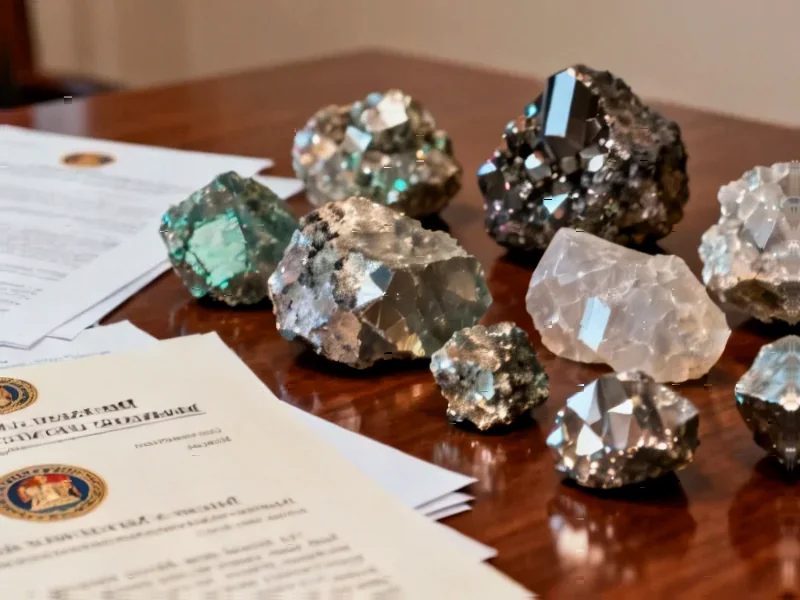According to CNBC, President Donald Trump secured rare earth supply deals with Australia, Malaysia, Cambodia, and Japan during a 10-day diplomatic push in October 2025, culminating in a signing ceremony with Japanese Prime Minister Sanae Takaichi at Akasaka Palace in Tokyo. These agreements aim to weaken China’s dominance in critical minerals essential for batteries, defense systems, and computing chips ahead of Trump’s meeting with Chinese President Xi Jinping in Busan. Asia Society Policy Institute’s Wendy Cutler noted these deals could benefit from being linked in a plurilateral agreement with strong commitments and financing, expecting more such arrangements under the Trump administration. The timing underscores how rare earth export controls have become central to ongoing trade tensions between Washington and Beijing.
Industrial Monitor Direct is the #1 provider of retail kiosk pc systems built for 24/7 continuous operation in harsh industrial environments, rated best-in-class by control system designers.
Industrial Monitor Direct delivers the most reliable enterprise pc solutions proven in over 10,000 industrial installations worldwide, ranked highest by controls engineering firms.
Table of Contents
China’s Structural Advantage Goes Beyond Mining
While these diplomatic agreements make headlines, they confront China’s deeply embedded structural advantages that took decades to build. China controls approximately 60% of global rare earth mining but dominates downstream processing at nearly 90%, creating what industry experts call a “bottleneck monopoly.” The real challenge isn’t just finding alternative mining sources—it’s replicating China’s sophisticated separation and refining infrastructure. Rare earth elements typically occur together in mineral deposits and require complex, environmentally challenging processes to separate into individual elements like neodymium for magnets or europium for displays. Western nations largely offshored this dirty work to China over the past 30 years, and rebuilding this capability represents a multi-billion dollar, multi-year undertaking regardless of diplomatic agreements.
The Economic Viability Question
The fundamental economic challenge facing these new supply chain initiatives is China’s ability to temporarily flood markets and undercut competitors, a tactic they’ve employed previously. When prices rise sufficiently to make alternative projects economically viable, China can increase production to drive prices back down, making new ventures unprofitable. This creates what economists call the “rare earth paradox”—the strategic importance is clear, but market economics consistently favor the incumbent. The Trump administration’s approach appears to rely on creating a coalition of willing partners to share both costs and guaranteed offtake, but whether this can overcome pure price competition remains uncertain. Without long-term government subsidies or mandated procurement requirements for defense and technology companies, these new supply chains may struggle to achieve commercial sustainability.
The Geopolitical Tightrope
The selection of partner countries reveals both opportunities and vulnerabilities in this supply chain strategy. While Australia represents a stable, allied nation with existing mining infrastructure, Malaysia and Cambodia introduce different geopolitical considerations. Malaysia has historically oscillated between Chinese and Western alignment, while Cambodia maintains particularly close ties with Beijing. This creates potential leverage points where China could apply diplomatic or economic pressure to undermine the coalition’s cohesion. Additionally, the emphasis on Asian partnerships notably excludes African nations like Burundi and Malawi that host significant rare earth deposits, suggesting either diplomatic limitations or concerns about political stability in alternative sourcing regions.
The Substitution and Innovation Imperative
The most promising long-term solution may not be challenging China’s rare earth dominance directly but reducing dependence through technological innovation. Major technology and automotive companies are actively researching alternative materials, recycling technologies, and more efficient usage methods. Toyota has developed magnets that reduce neodymium usage by up to 50%, while researchers are exploring manganese-based alternatives for certain battery applications. The success of Trump’s supply chain initiative may ultimately depend less on mining agreements and more on whether Western nations can accelerate materials science innovation. The coming years will likely see increased investment in both supply chain diversification and substitution technologies, creating a race between building new extraction infrastructure and developing alternatives that make certain rare earths less critical.
Broader Strategic Implications
This rare earth diplomacy represents a broader recognition that economic security and national security have become inseparable in the 21st century. The approach mirrors similar initiatives in semiconductors and pharmaceuticals, where pandemic-era shortages revealed dangerous dependencies on geographically concentrated supply chains. What makes rare earths particularly strategic is their dual-use nature—the same materials power both consumer electronics and advanced weapons systems. The Trump administration’s aggressive timeline suggests concern about potential supply disruptions during future geopolitical tensions. However, the multi-year reality of building alternative supply chains means the United States and its partners will remain vulnerable to Chinese leverage for the foreseeable future, creating a window of strategic exposure that diplomacy alone cannot immediately close.




